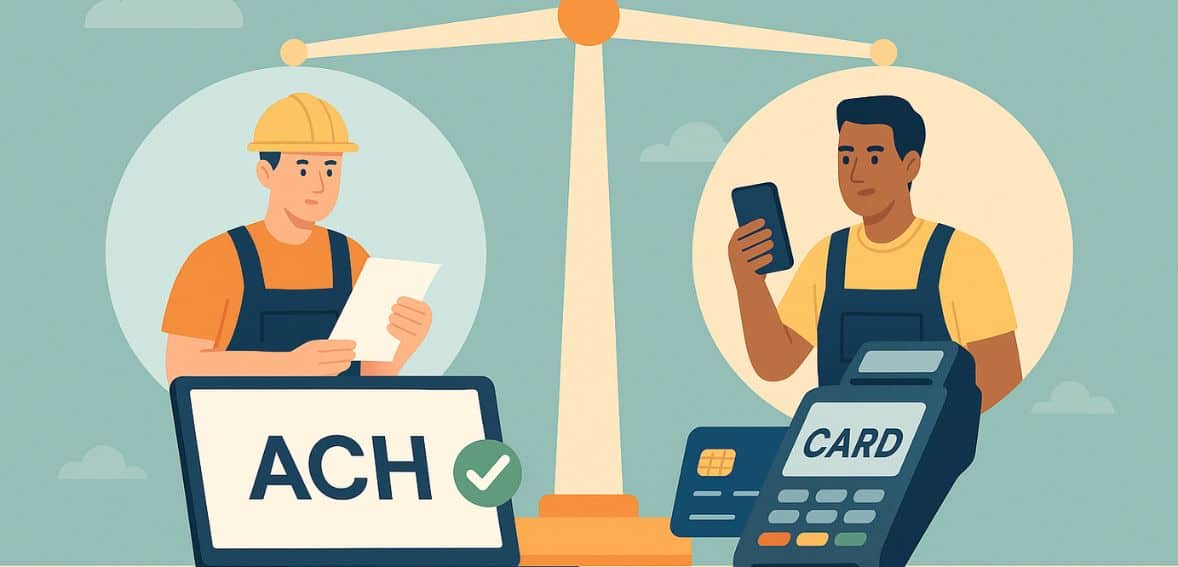
By alphacardprocess July 27, 2025
Payment practices for field service providers and contractors are rapidly evolving. The emergence of digital payments has created new opportunities in an industry that previously relied significantly on checks and cash. Now at the forefront of the conversation are two of the most widely used payment methods: card payments and ACH (Automated Clearing House) transfers.
Each approach has advantages and disadvantages, and the best approach for you will depend on how your company is set up. Depending on your business model, contractors today require options that are quick, inexpensive, and convenient. Making an informed decision requires knowing each method’s true cost, speed, customer experience, and dependability.
Understanding ACH Transfers in Field Services

ACH transfers transfer funds straight between banks, typically from a business account to a customer’s checking account. This can be an affordable method of payment for contractors, particularly in larger transactions. Like card readers, ACH doesn’t require any hardware, and it can be a simple and reliable method of guaranteeing payment for ongoing projects or loyal customers.
However, ACH isn’t instant. Transactions can take one to three business days to clear, and they may bounce back if a customer enters incorrect information or doesn’t have enough money. Nevertheless, it provides an alluring low-fee model with predictable settlements once set up correctly for those performing large-scale or repetitive work—think roofing companies, HVAC teams, or pest control services.
Card Payments: Speed, Convenience, and Customer Preference

Card payments, on the other hand, offer immediacy. Consumers are accustomed to using credit or debit cards both online and in physical stores. Nowadays, a lot of field service providers have mobile card readers, which makes it simple to take payments on the spot. Card payments can result in faster cash flow and less administrative follow-up for companies that deal with a large number of customers or need to close deals quickly, such as home repair, cleaning services, or lawn care.
However, there are higher transaction fees associated with using a credit or debit card, typically between 2 and 4%. That expense quickly mounts up, particularly for expensive work. However, some business owners believe that the dependability and customer satisfaction that card payments provide make the cost worthwhile.
Cost Breakdown: What You’re Paying For
Although ACH may appear more attractive due to the upfront fees, you must consider all factors, not just the cost per transaction. POS systems, chargeback protection, next-day funding, customer portals, and even recurring billing are among the more integrated services that card payment processors usually provide. For some contractors, the slightly higher price may be justified by these extra services.
Although ACH processors are typically less expensive, their services are more constrained. For reminders, job scheduling software integrations, or invoicing, you may need to pay for third-party tools. In addition to the transaction fee, business owners must evaluate the tools that facilitate their work, the time spent pursuing payments, and the hidden labor costs. For smoother operations, many businesses are also turning to contractor invoicing tools that streamline billing and payouts without adding overhead.
Customer Experience and Ease of Use
Consumers tend to choose the simplest options. For many, that entails using a saved profile to make an online payment or tapping a card. Offering card payments could enhance the overall customer experience if you work in residential services, where clients are accustomed to consumer-level technology. They can use their phone to make reservations, confirm, and make payments.
However, ACH can also be streamlined, particularly with contemporary invoicing systems that support bank transfers through secure connections. Due to the ability to handle larger invoices and prevent expensive credit card fees, contractors who work with commercial clients or provide business-to-business services frequently discover that companies prefer ACH over card payments. Your chances of getting paid on time increase with how well you match your customers’ payment preferences.
Security and Chargebacks: What to Watch Out For

Another important factor is security. Chargebacks are less likely to occur with ACH payments, which is very advantageous in sectors where disagreements may occur. Without concrete evidence, it is difficult for the customer to reverse an ACH transfer once it has cleared. Despite being quick and simple, card payments allow chargebacks.
Resolving a customer’s charge dispute may take weeks or even months. That process can tie up your cash flow and cost you money in lost time and fees. Yet, some card processors provide fraud protection and dispute resolution tools, providing you with some insurance. It all comes down to striking a balance between risk and speed and putting a mechanism in place to deal with problems before they become out of control.
Some processors also offer chargeback insurance, which can provide an added layer of protection when dealing with high-risk transactions or disputed charges.
Navigating Refunds and Chargebacks with ACH and Card Payments
Field service providers and contractors must deal with cancellations, project delays, and customer disputes that result in chargebacks or refunds whenever they process payments. These situations are handled very differently by ACH and card payments, which can have an effect on cash flow and customer satisfaction.
Chargebacks are more frequent with card payments and are strictly regulated by card networks. Weeks after a transaction, customers may contest a charge, which may result in refunded funds and other costs—even if the work was done. This unpredictability adds stress to smaller operations. Nonetheless, consumers value the fraud protections that credit card companies frequently provide.
However, once processed, ACH transactions are more difficult to reverse. This lowers the possibility of chargebacks, but it also restricts your options if you need to promptly reimburse a customer. Refunds are permitted by the majority of ACH providers; however, they may require extra steps or expenses and take longer to process than card refunds.
Contractors must choose between reducing disputes and providing prompt, flexible refunds. In order to achieve the ideal balance between operational effectiveness and customer satisfaction, businesses frequently adopt both approaches.
Recurring Billing and Subscription Services

Recurring service models are becoming popular among contractors. Consider a weekly lawn care service or a quarterly pest control service. Because it allows for low-cost recurring payments, ACH is great for this. Subscriptions are also supported by card payments, but the higher costs may reduce your profit margins.
Positively, cards can be updated automatically if they are misplaced or expire; ACH does not provide that option. Both strategies can be effective if you want to generate recurring income, but it’s important to consider your average ticket size, customer volume, and payment failure risk. For companies that wish to have the best of both worlds, a hybrid approach might be the best course of action.
Contract Terms, Processing Times, and Flexibility
Some ACH providers may batch transactions in a way that slows down your cash flow, and they frequently have stricter transfer schedules. Speed is often a top priority for card processors, particularly those designed for service-oriented enterprises. If you’re paying subcontractors or purchasing materials up front, some provide same-day or next-day funding, which can make a big difference.
Adaptability is also important. While some processors work on a month-to-month basis, others bind you to lengthy contracts. Spend some time reading the fine print when comparing ACH and card processing options. Keep an eye out for any minimum monthly usage requirements, cancellation penalties, and hidden fees that might not be apparent at first.
Scalability: As Your Business Grows
Your payment system should grow with your company. Scalability becomes a key consideration for contractors opening an office, hiring more employees, or entering new areas. Although ACH may save you money on each transaction, you may quickly outgrow it if the platform doesn’t offer reporting, user access control, or mobile support. However, card processors, particularly those that are cloud-based these days, provide tools that grow with you.
Customer analytics, marketing tools, loyalty integrations, and dashboards with multiple users are becoming commonplace. Being able to view and act on payment data quickly can give you a significant advantage as your clientele grows. Consider what will still be effective in five years rather than just what is effective right now.
Mixing Both: Is a Hybrid Model the Answer
Many contractors don’t have to choose one approach and use it consistently. Your company might benefit most from a hybrid model. For instance, encourage commercial clients to use ACH for larger or ongoing contracts while providing card payments to residential clients who demand quick service and a simple checkout process. The secret is to offer your customers choices without making things too difficult for you.
Reconciliation can be made easier, errors can be decreased, and your experience can be enhanced by using a single platform that accepts both forms of payment. It might be time to reevaluate how much time on admin you’re wasting and what digital alternatives could take the place of checks or cash collections.
Conclusion: Making the Right Choice for Your Operation
When it comes to selecting between ACH and card payments, there is no absolute right or wrong answer. The type of work you do, the average size of your transactions, the frequency of your billing, and the preferences of your clients will all influence the best option. Field service companies and contractors have to balance transaction costs against risk, speed, and convenience.
ACH will provide the best cost-reliability ratio for some. Others will find that the advantages of quicker card payments and familiarity with the customer outweigh the additional cost. Offering both frequently guarantees that you maintain your flexibility, satisfy your clients, and receive payment on time. Investing in a payment system that suits your business model is one of the best decisions you can make, regardless of the approach you prefer.